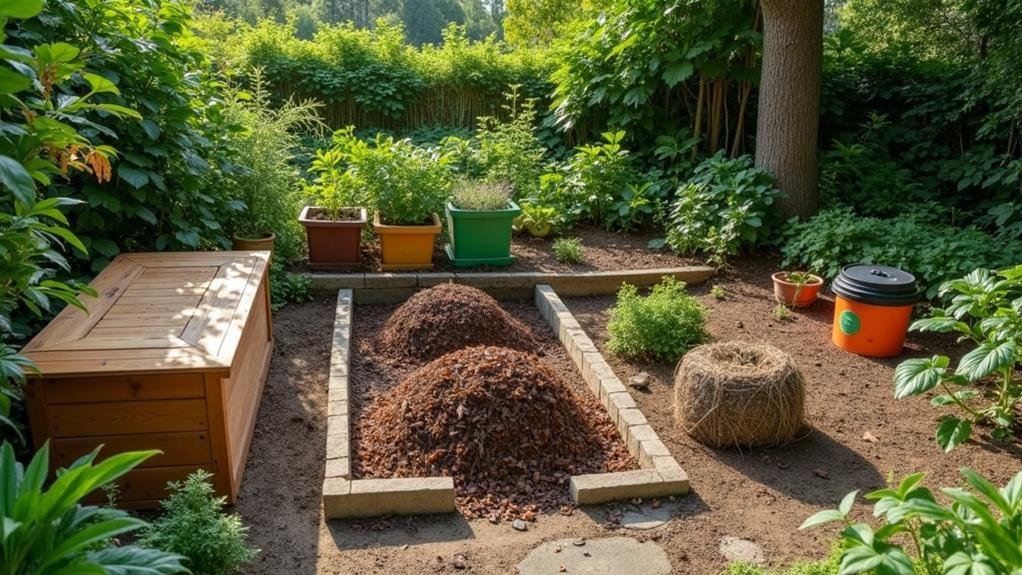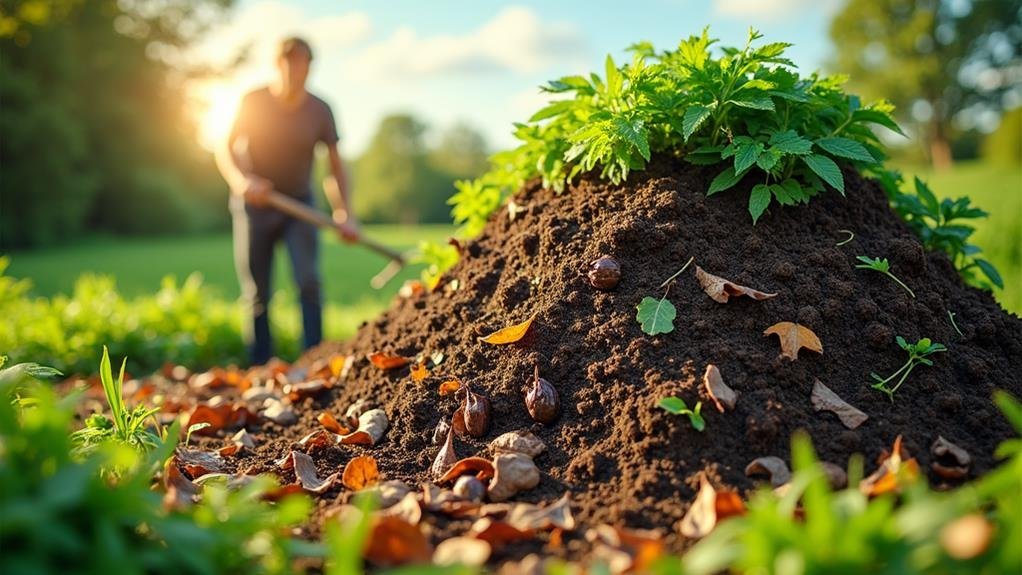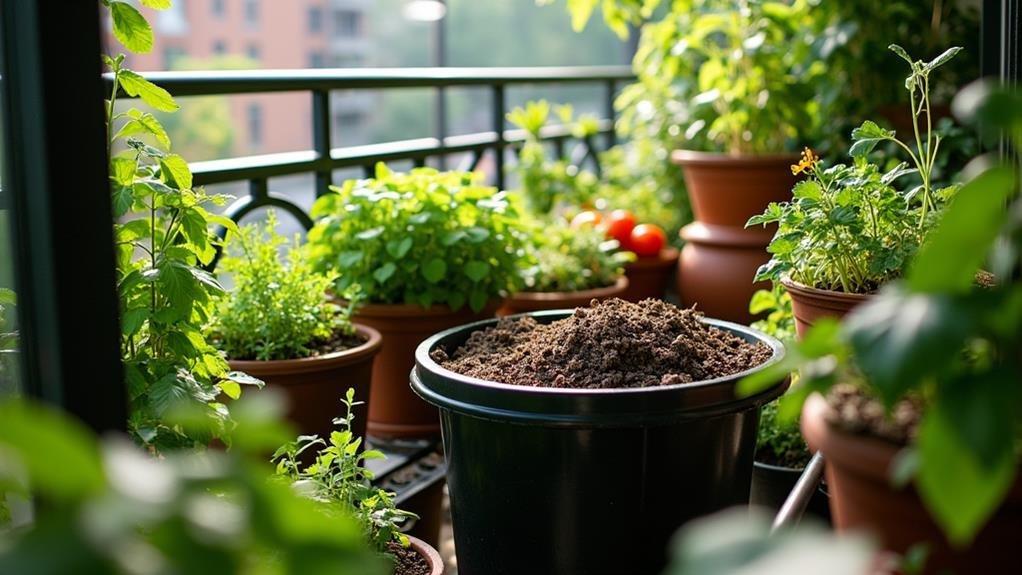If you're considering composting in your home garden, you're likely aware of its benefits for both your plants and the environment. You might not know, though, that there are several effective methods to choose from, each with its own set of advantages. From traditional composting to innovative techniques like vermicomposting and Bokashi, there's a solution that suits your space and lifestyle. As you investigate these options, you'll find that some methods can even save you time and effort while enhancing your soil. Let's take a closer look at the top seven methods that could transform your gardening experience.
In addition to exploring different composting methods, it’s also important to consider soil preparation tips to ensure the success of your garden. Proper soil preparation can have a significant impact on the health and vitality of your plants, so it’s worth taking the time to learn about techniques such as double digging, adding organic matter, and performing soil tests. By incorporating these soil preparation tips along with the right composting method, you can create a thriving and sustainable garden for years to come.
Traditional Composting Bins
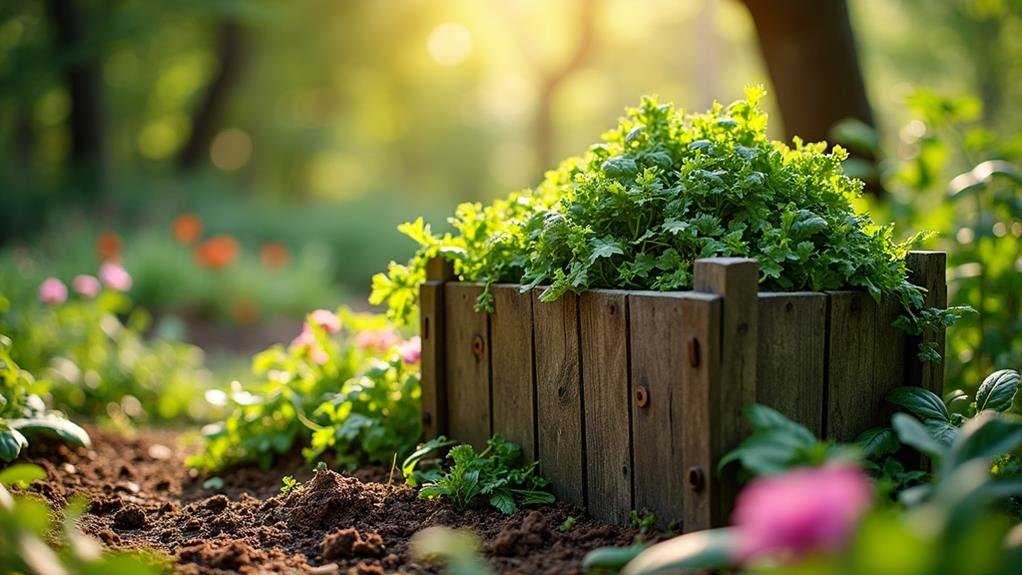
Creating a thriving garden begins with the essential practice of composting, and traditional composting bins are a fantastic way to get started. These bins provide a structured environment for organic waste, turning kitchen scraps and yard debris into rich, nutrient-dense compost. You'll appreciate how easy it's to set one up.
First, choose a location for your bin—ideally, a spot that's easily accessible but shaded. You can buy a pre-made bin or construct your own using wood pallets or wire mesh.
Next, layer your materials. Start with coarse materials like twigs for aeration, then alternate with green waste like vegetable peels and brown waste like dried leaves.
Keep your compost moist but not soggy, and turn it occasionally to speed up decomposition. You'll see the magic happen as microorganisms break down your waste into dark, crumbly compost.
This process usually takes a few months, but patience pays off when you add that homemade compost to your garden.
Vermicomposting Systems
While traditional composting bins work well for many gardeners, vermicomposting systems offer an innovative and efficient alternative. By using worms, specifically red wigglers, you can speed up the decomposition process and create nutrient-rich compost.
This method is perfect for small spaces, like apartments or patios, as it requires minimal room.
To set up a vermicomposting system, you'll need a bin with air holes, bedding material like shredded paper or coconut coir, and, of course, your worms.
Simply layer the bedding, add your worms, and start feeding them kitchen scraps like fruit peels, coffee grounds, and vegetable trimmings. Avoid meat, dairy, and oily foods to keep odors at bay.
Over time, the worms will break down the scraps into rich, dark compost known as worm castings. You can harvest this compost every few months for your garden, providing a powerful boost to your plants.
Just remember to keep the bin moist but not soggy, and check on your worms regularly to make certain they're thriving.
With a bit of care, vermicomposting can transform your kitchen scraps into a gardener's gold!
Bokashi Composting Technique
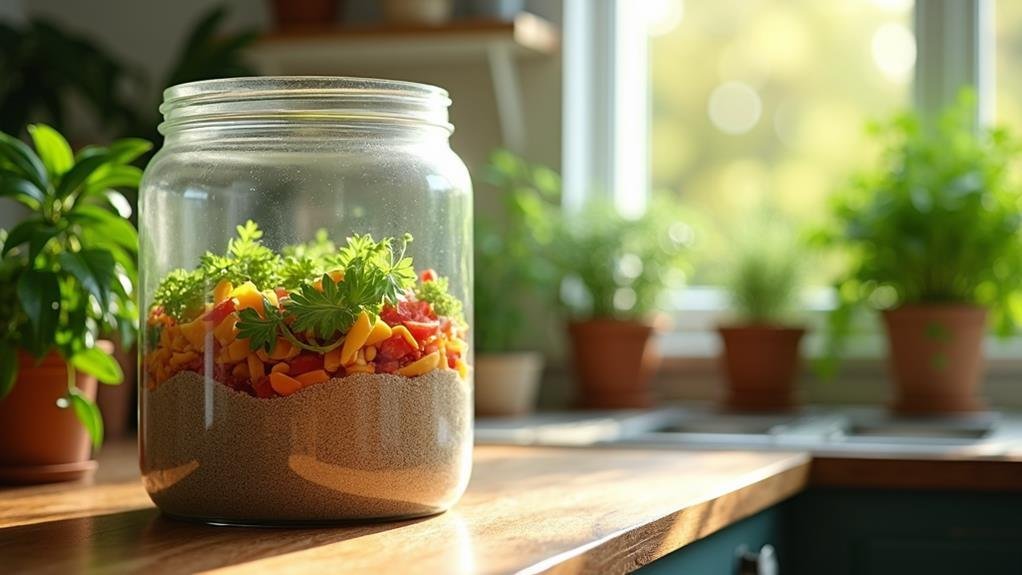
Bokashi composting is a unique and effective method that allows you to ferment kitchen waste instead of composting it in the traditional sense. This technique utilizes a special blend of microorganisms, often found in Bokashi bran, to break down organic matter rapidly.
To get started, you'll need a Bokashi bin, which is an airtight container designed to keep odors in and pests out.
Simply layer your kitchen scraps—like fruit peels, vegetable trimmings, and even dairy products—into the bin. Sprinkle a handful of the Bokashi bran over each layer to introduce those beneficial microbes.
After filling the bin, seal it tightly and let it sit for about two weeks. During this time, the microorganisms will ferment the waste, producing a nutrient-rich liquid you can use as a fertilizer.
Once the fermentation process is complete, you can bury the contents in your garden or mix it into your compost pile.
Bokashi composting is great for those who want to minimize waste and speed up the composting process. Plus, it allows you to compost food items that may not be suitable for traditional methods.
Give it a try and watch your garden thrive!
Hot Composting Method
The hot composting method is a dynamic way to transform kitchen scraps and yard waste into rich, fertile soil. This technique involves creating a compost pile that reaches high temperatures, typically between 130°F to 160°F. To achieve this, you'll need a balanced mix of "greens" (nitrogen-rich materials) and "browns" (carbon-rich materials). Aim for a ratio of about 2:1, which helps kickstart the decomposition process.
To begin, layer your materials in a pile or bin, ensuring you include air pockets. Turning the pile every few weeks introduces oxygen, which is essential for the microorganisms breaking down the waste. You'll notice the temperature rising as these microbes get to work, breaking down your compost in as little as four to six weeks.
Keep the pile moist, like a damp sponge, but not soggy. If you see steam rising, you're on the right track!
Once the compost cools and turns dark and crumbly, you've created nutrient-rich soil. Hot composting not only reduces waste but also gives you an excellent product for your garden. So, roll up your sleeves and enjoy the process!
Tumbler Composting
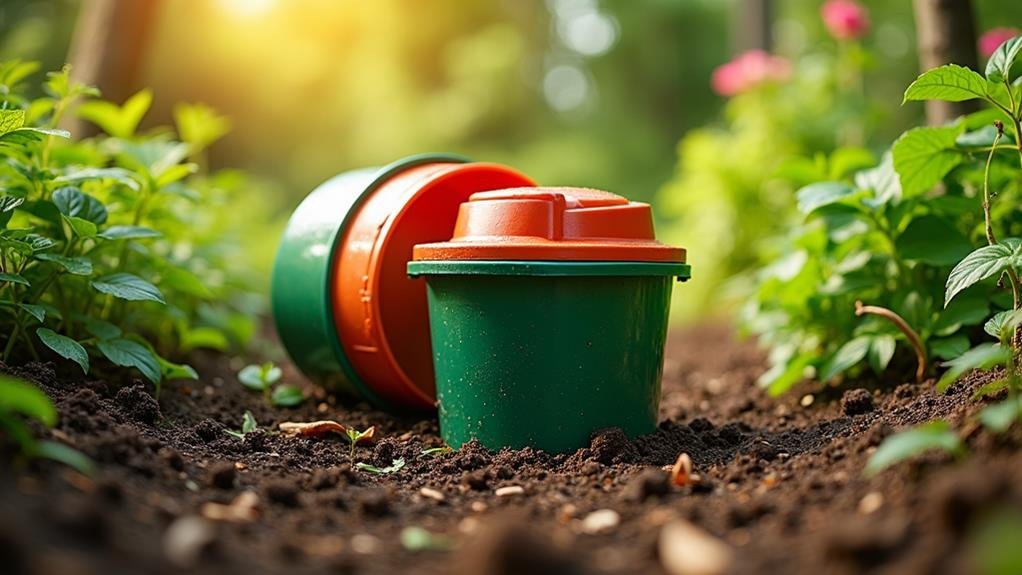
If you're looking for a more convenient way to compost, tumbler composting might be the solution for you. This method uses a sealed, rotating container that makes it easy to mix your compost materials without the hassle of traditional compost piles. By simply turning the tumbler, you can aerate your compost, which helps speed up the decomposition process.
Tumbler composters come in various sizes and designs, allowing you to choose one that best fits your space and needs. They're typically made from durable materials, keeping pests out while maintaining the right moisture levels.
You'll find that these tumblers make it simple to track your compost's progress, as you can easily check the contents through the viewing windows.
One of the main advantages of tumbler composting is its efficiency. With proper balance between greens and browns, you can produce finished compost in just a few weeks.
Plus, it's a cleaner option since the enclosed design prevents spills and keeps your yard tidy. So, if you're ready to streamline your composting efforts, consider investing in a tumbler. You'll appreciate the ease and speed it brings to your home gardening routine.
Sheet Composting
While sheet composting mightn't be as familiar as other methods, it's a fantastic way to enrich your garden soil with minimal effort. This technique involves layering organic materials directly onto the soil, allowing them to decompose naturally over time. You can use items like cardboard, leaves, grass clippings, and kitchen scraps. Simply spread these materials across the area you want to improve.
One of the best parts about sheet composting is its simplicity. You don't need fancy equipment or a lot of space. Just make sure to layer your materials in a way that promotes proper decomposition. For instance, start with a carbon-rich layer, such as dry leaves or straw, followed by nitrogen-rich materials like fresh grass clippings or vegetable scraps.
As the layers break down, they'll add nutrients back into the soil, improving its structure and fertility. Plus, you'll suppress weeds and help retain moisture.
You can even plant directly into the compost layers after a few weeks. So, if you're looking for an easy, eco-friendly way to boost your garden, give sheet composting a try. It's a great way to recycle waste while nurturing your plants!
Trench Composting
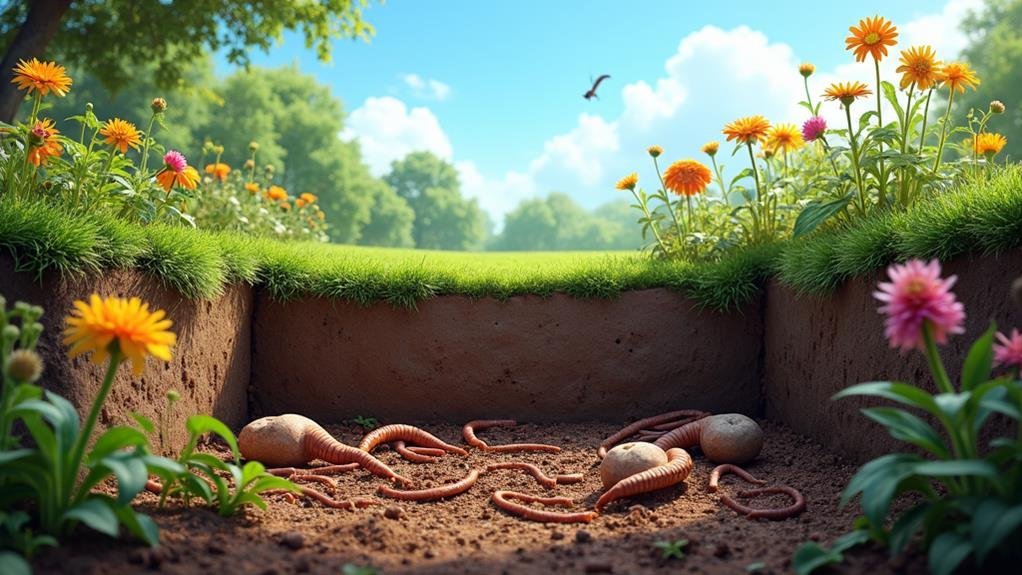
Trench composting is a simple yet effective method that can greatly improve your garden soil. This technique involves digging a trench in your garden, usually about one foot deep, and burying kitchen scraps, yard waste, or other organic materials directly in the soil. Over time, these materials decompose, enriching the soil with nutrients and enhancing its structure.
To get started, choose a spot in your garden that needs a nutrient boost. Dig a trench that's long enough to accommodate the waste you plan to add. Next, layer in your organic materials, making sure to mix in some brown materials like dried leaves or cardboard to balance the nitrogen-rich greens.
Cover the trench with soil, and let nature do its work. You won't have to worry about odors or pests as the compost breaks down underground. Plus, trench composting improves soil aeration and moisture retention.
It's a great way to recycle waste while benefiting your plants. So, if you're looking for an effortless way to compost, give trench composting a try. Your garden will thank you!
Conclusion
Incorporating one or more of these composting methods into your home garden can greatly improve your soil health and reduce waste. Whether you choose traditional composting, vermicomposting, or any of the other techniques, each option offers unique benefits tailored to your lifestyle. You'll not only contribute to a healthier environment but also enjoy the satisfaction of nurturing your plants with nutrient-rich compost. So, roll up your sleeves and get started—your garden will thank you!

